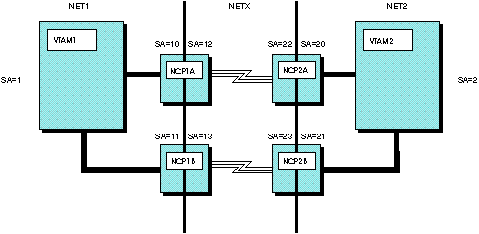 |
You need to code CDRM definition statements
for VTAMs in other networks with which this VTAM® requires direct communication.
ProcedurePerform the following steps in a CDRM major
node: - Add one NETWORK definition statement for each network to be connected through a gateway
NCP. This is necessary to identify the networks that contain
the defined CDRMs.
The NETID operand of the NETWORK definition
statement identifies the network that contains the defined CDRMs.
All the CDRMs that follow a given NETWORK definition statement must
belong to that network.
The value coded for NETID on the NETWORK
definition statement must match the NETID start option specified for
the CDRM in its own domain. CDRM definition statements for CDRMs in
the same network as this host CDRM can follow a NETWORK definition
statement whose NETID identifies the network that contains this host
CDRM.
By coding a NETWORK definition statement for every network
(including that of the host CDRM), you can use the same set of CDRM
definitions at hosts in different networks. (However, these hosts
must all have VTAM Version
2 Release 2 or later releases.)
- Add one CDRM definition statement for each SSCP in another network with which the gateway VTAM is in session (this is required).
The CDRM names defined in the gateway SSCP must be unique and
must immediately follow their own NETWORK definition statement.
- Add one or more GWPATH definition statements after each CDRM definition statement that defines
an SSCP in another network. If you specify the GWSSCP=YES
start option, you can use a GWPATH definition statement in conjunction
with a CDRM definition statement. In this case, the value of the ELEMENT
operand on the GWPATH definition statement must match that defined
with a GWNAU definition statement in the gateway NCP through which
the gateway SSCP is reached. If the gateway SSCP can be reached through
multiple gateway NCPs, multiple GWPATH definition statements can be
associated with the single CDRM definition statement defining the
gateway SSCP. (This is required for CDRMs in other networks that are
not predefined in the gateway NCP.)
GWPATH definition statements
define one or more cross-network session paths to be used for cross-network
LU-LU and SSCP-SSCP sessions.
If no GWPATH definition statement
is coded, VTAM uses the SUBAREA
value specified on the CDRM definition statement to select a gateway
NCP. The ELEMENT value on the CDRM definition statement must match
that specified by the GWNAU definition statement for a predefined
CDRM in the gateway NCP.
The ADJNETSA and ADJNETEL operands
on the GWPATH definition statement must specify the subarea and element
numbers of the CDRM as they are known in the adjacent network. For
a back-to-back gateway NCP configuration, these numbers are obtained
from the SUBAREA and ELEMENT operands on the GWNAU definition statement
that defines this external CDRM in the second gateway NCP in the back-to-back
configuration. For information about how the gateway path is selected,
see Gateway path selection.
Using the ADJNETCS
operand on the GWPATH definition statement, you can specify the Class
of Service name to be used for establishing the route for the SSCP-SSCP
session. Usually, this Class of Service name is ISTVTCOS. If you specify
ADJNETCS, VTAM does not invoke
the NetView® alias name translation
facility or the session management exit routine to perform Class of
Service translation.
- The value you code on the SUBAREA operand of the CDRM definition
statement should be the subarea in the gateway NCP through which the
gateway SSCP is reached. The ELEMENT operand for the CDRM
definition statement must match the element predefined for the gateway VTAM with a GWNAU definition statement
in that gateway NCP. If these operands are not defined, it is impossible
to initiate an SSCP-SSCP session between the nongateway VTAM and a gateway SSCP in another network.
If the gateway SSCP can be reached through multiple gateway NCPs,
it appears as multiple CDRMs (that is, as SSCPs in different subareas)
from the point of view of the nongateway SSCP. If a gateway NCP failure
disrupts the SSCP-SSCP session between the nongateway SSCP and the
gateway SSCP, reactivation of the session through a different gateway
NCP is possible if you provide multiple CDRM definition statements
for the gateway SSCP. Each of these definition statements must have
a unique label. The SUBAREA operand specifies the subarea of one of
the gateway NCPs, and the element value is reserved for the gateway
SSCP with a GWNAU definition statement coded in that gateway NCP subarea.
Given these definitions, the operator at either the gateway SSCP or
the nongateway SSCP can reestablish the SSCP-SSCP session through
an alternate gateway NCP.
Results Figure 1 is an example of
an SNI back-to-back configuration.
Figure 1. Multiple-network
configuration: CDRM major nodes
Code the following in the CDRM major node in VTAM1: NET1 NETWORK NETID=NET1
VTAM1 CDRM SUBAREA=1,
⋮
NET2 NETWORK NETID=NET2
VTAM2 CDRM
NCP1A GWPATH SUBAREA=10,
ELEMENT=1,
ADJNET=NETX,
ADJNETSA=22,
ADJNETEL=1,
NCP1B GWPATH SUBAREA=11,
ELEMENT=1,
ADJNET=NETX,
ADJNETSA=23,
ADJNETEL=1,
It is recommended that
you code the ELEMENT operand rather than accepting the default. In
this way, it is easier to ensure that you do not have the same subarea
and element number for multiple resources.
The CDRM major node
in VTAM1 shows that you need to code a GWPATH definition statement
for each gateway NCP. Note that you need to be careful to match the
NCP pairs (NCP1A with NCP2A and NCP1B with NCP2B) to ensure that the
CDRM-CDRM session uses the same pair of gateway NCPs.
Thus,
code the following in the CDRM major node in VTAM2: NET2 NETWORK NETID=NET2
VTAM2 CDRM SUBAREA=2,
⋮
NET1 NETWORK NETID=NET1
VTAM1 CDRM
NCP2A GWPATH SUBAREA=20,
ELEMENT=1,
ADJNET=NETX,
ADJNETSA=12,
ADJNETEL=1,
NCP2B GWPATH SUBAREA=21,
ELEMENT=1,
ADJNET=NETX,
ADJNETSA=13,
ADJNETEL=1,



|
 z/OS Communications Server: SNA Network Implementation Guide
z/OS Communications Server: SNA Network Implementation Guide
 z/OS Communications Server: SNA Network Implementation Guide
z/OS Communications Server: SNA Network Implementation Guide




 Copyright IBM Corporation 1990, 2014
Copyright IBM Corporation 1990, 2014